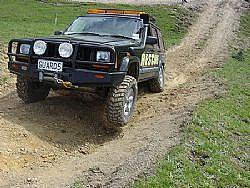A 4WD vehicle – any 4WD – is an expensive investment, especially if you’ve just bought one of the latest versions with all the bells and whistles. But are you getting value out of it?
One of the best ways you can get the most out of your 4WD, and ensure your safety and that of your family, is to enrol for a 4WD training course. Whether it’s to enhance your pleasure, or to make sure you’re able to do your job properly, it will be money well spent.
Better still, if you’re a business and you use 4WDs in that business, training is money well spent –it will limit wear and tear on your vehicles, cut down-time, and most important, help prevent injury or worse to your valuable staff. And some courses are subsidised by the government through the Industry Training Fund, which means they are virtually free.
In fact, if one does a quick search on the Internet it’s amazing just how many names of 4WD training organisations in New Zealand spring up. We have taken a few at random, based on people we have had contact with, or those who have contacted us, but the list is by no means complete – in fact we’ve only scratched the surface.
Although most drivers can adjust to the extra size and weight of a 4WD when it comes to driving on normal roads, all this changes when it comes to off-road driving. Many people try to learn by trial and error, but most of the time it’s error, and a lot can go wrong, especially if you venture off on your own.
At the time it’s fun, but it all stops being a laugh when your vehicle gets stuck up to the axles in sand with the tide coming in and nobody to help you get out!
If only, you cry, head in hands!
Quite often the first things a new owner will want to do after getting his or her 4WD is make it look better. A winch, bigger wheels and tyres, roof rack, raised suspension – the list is quite endless, but in reality should only be looked at after the most important thing has been seen to – training. OK, you’ve bought into the concept – but where do you start - there are, as we said, more 4WD trainers than you can count. .:
Although most people want to get out and start having fun, it’s essential that you have a session in the classroom where you can learn how and why a 4WD works, as well as its limitations. Once behind the wheel, you should learn:
The basic principles of control and traction. What is meant by “as slow as possible, as fast as necessary”.
How to reverse a vehicle off-road. It’s not just a matter of changing gear and turning around in your seat…
How to drive a 4WD vehicle on-road. It’s not just a big wagon – riding high, and often with knobbly tyres, produces its own set of handling characteristics.
The basics of how to “read” tracks and track conditions so you get through easily and without fuss – and when to avoid trouble and go another route.
One of the most important lessons is how to climb and descend steep slopes. This is where most people get into trouble, and potentially the most dangerous. Intrinsic in this is what’s known as the “failed hill start” – what to do if you can’t get any further uphill, and especially if the engine stalls.
An understanding of the environmental damage a 4WD can do, and how to minimise it.
Driving on side slopes, where absolutely necessary
How to cross streams and rivers, and
to drive in deep water.
How to self-recover a vehicle after it’s become stuck. This is particularly important for those who have to go out on their own, such as land surveyors, or families out for the day or weekend.
How to drive in the kinds of conditions likely to be encountered in your area,
or in the places you intend to visit – such as sand, clay, wet grass, etc.
Understanding your own limitations,
as well as those of your vehicle. .:
Training wheels
Saturday, 24 March 2007




